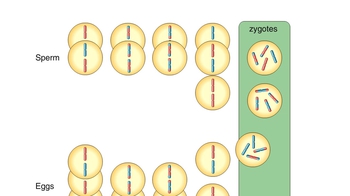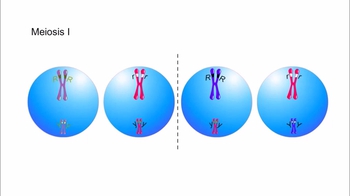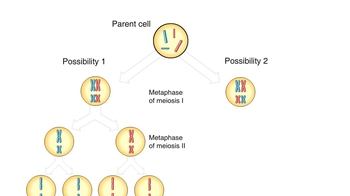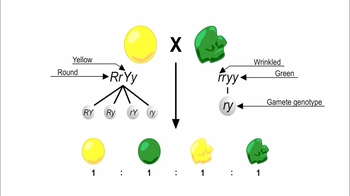Table of contents
- 1. Introduction to Biology2h 42m
- 2. Chemistry3h 40m
- 3. Water1h 26m
- 4. Biomolecules2h 23m
- 5. Cell Components2h 26m
- 6. The Membrane2h 31m
- 7. Energy and Metabolism2h 0m
- 8. Respiration2h 40m
- 9. Photosynthesis2h 49m
- 10. Cell Signaling59m
- 11. Cell Division2h 47m
- 12. Meiosis2h 0m
- 13. Mendelian Genetics4h 44m
- Introduction to Mendel's Experiments7m
- Genotype vs. Phenotype17m
- Punnett Squares13m
- Mendel's Experiments26m
- Mendel's Laws18m
- Monohybrid Crosses19m
- Test Crosses14m
- Dihybrid Crosses20m
- Punnett Square Probability26m
- Incomplete Dominance vs. Codominance20m
- Epistasis7m
- Non-Mendelian Genetics12m
- Pedigrees6m
- Autosomal Inheritance21m
- Sex-Linked Inheritance43m
- X-Inactivation9m
- 14. DNA Synthesis2h 27m
- 15. Gene Expression3h 20m
- 16. Regulation of Expression3h 31m
- Introduction to Regulation of Gene Expression13m
- Prokaryotic Gene Regulation via Operons27m
- The Lac Operon21m
- Glucose's Impact on Lac Operon25m
- The Trp Operon20m
- Review of the Lac Operon & Trp Operon11m
- Introduction to Eukaryotic Gene Regulation9m
- Eukaryotic Chromatin Modifications16m
- Eukaryotic Transcriptional Control22m
- Eukaryotic Post-Transcriptional Regulation28m
- Eukaryotic Post-Translational Regulation13m
- 17. Viruses37m
- 18. Biotechnology2h 58m
- 19. Genomics17m
- 20. Development1h 5m
- 21. Evolution3h 1m
- 22. Evolution of Populations3h 52m
- 23. Speciation1h 37m
- 24. History of Life on Earth2h 6m
- 25. Phylogeny2h 31m
- 26. Prokaryotes4h 59m
- 27. Protists1h 12m
- 28. Plants1h 22m
- 29. Fungi36m
- 30. Overview of Animals34m
- 31. Invertebrates1h 2m
- 32. Vertebrates50m
- 33. Plant Anatomy1h 3m
- 34. Vascular Plant Transport1h 2m
- 35. Soil37m
- 36. Plant Reproduction47m
- 37. Plant Sensation and Response1h 9m
- 38. Animal Form and Function1h 19m
- 39. Digestive System1h 10m
- 40. Circulatory System1h 57m
- 41. Immune System1h 12m
- 42. Osmoregulation and Excretion50m
- 43. Endocrine System1h 4m
- 44. Animal Reproduction1h 2m
- 45. Nervous System1h 55m
- 46. Sensory Systems46m
- 47. Muscle Systems23m
- 48. Ecology3h 11m
- Introduction to Ecology20m
- Biogeography14m
- Earth's Climate Patterns50m
- Introduction to Terrestrial Biomes10m
- Terrestrial Biomes: Near Equator13m
- Terrestrial Biomes: Temperate Regions10m
- Terrestrial Biomes: Northern Regions15m
- Introduction to Aquatic Biomes27m
- Freshwater Aquatic Biomes14m
- Marine Aquatic Biomes13m
- 49. Animal Behavior28m
- 50. Population Ecology3h 41m
- Introduction to Population Ecology28m
- Population Sampling Methods23m
- Life History12m
- Population Demography17m
- Factors Limiting Population Growth14m
- Introduction to Population Growth Models22m
- Linear Population Growth6m
- Exponential Population Growth29m
- Logistic Population Growth32m
- r/K Selection10m
- The Human Population22m
- 51. Community Ecology2h 46m
- Introduction to Community Ecology2m
- Introduction to Community Interactions9m
- Community Interactions: Competition (-/-)38m
- Community Interactions: Exploitation (+/-)23m
- Community Interactions: Mutualism (+/+) & Commensalism (+/0)9m
- Community Structure35m
- Community Dynamics26m
- Geographic Impact on Communities21m
- 52. Ecosystems2h 36m
- 53. Conservation Biology24m
12. Meiosis
Genetic Variation During Meiosis
Problem 9`
Textbook Question
Meiosis results in independent assortment of maternal and paternal chromosomes. If 2n=6 for a given organism, and there is no crossing over, what is the chance that a gamete produced by this diploid organism will receive only paternal chromosomes?
a. 0
b. 1/16
c. 1/8
d. 1/3
 Verified step by step guidance
Verified step by step guidance1
Understand that meiosis involves the separation of homologous chromosomes into gametes, resulting in independent assortment. This means each gamete receives a random mix of maternal and paternal chromosomes.
Identify that the diploid number (2n) is 6, meaning there are 3 pairs of homologous chromosomes (n=3). Each pair consists of one maternal and one paternal chromosome.
Recognize that for a gamete to receive only paternal chromosomes, it must receive the paternal chromosome from each of the 3 pairs.
Calculate the probability of receiving the paternal chromosome from one pair, which is 1/2, since there are two equally likely outcomes (maternal or paternal).
Determine the overall probability by multiplying the probabilities for each pair: \( \left( \frac{1}{2} \right)^3 \). This represents the chance of receiving paternal chromosomes from all three pairs.
 Verified video answer for a similar problem:
Verified video answer for a similar problem:This video solution was recommended by our tutors as helpful for the problem above
Video duration:
2mPlay a video:
Was this helpful?
Key Concepts
Here are the essential concepts you must grasp in order to answer the question correctly.
Meiosis
Meiosis is a type of cell division that reduces the chromosome number by half, resulting in four genetically distinct gametes. It consists of two stages: meiosis I and meiosis II. Meiosis I is where homologous chromosomes are separated, leading to independent assortment, which is crucial for genetic diversity.
Recommended video:
Guided course

Meiosis I & Meiosis II
Independent Assortment
Independent assortment refers to the random distribution of maternal and paternal chromosomes into gametes during meiosis. This occurs during metaphase I when homologous chromosome pairs align independently at the cell's equator, allowing for various combinations of chromosomes in the resulting gametes.
Recommended video:
Guided course

Independent Assortment
Probability in Genetics
Probability in genetics involves calculating the likelihood of specific genetic outcomes. For a diploid organism with 2n=6, there are three pairs of homologous chromosomes. Without crossing over, each pair can independently assort into gametes, leading to 2^3 (or 8) possible combinations. The chance of a gamete receiving only paternal chromosomes is 1/8.
Recommended video:
Guided course

Punnett Square Probability

 7:08m
7:08mWatch next
Master Genetic Variation During Meiosis with a bite sized video explanation from Jason
Start learningRelated Videos
Related Practice














